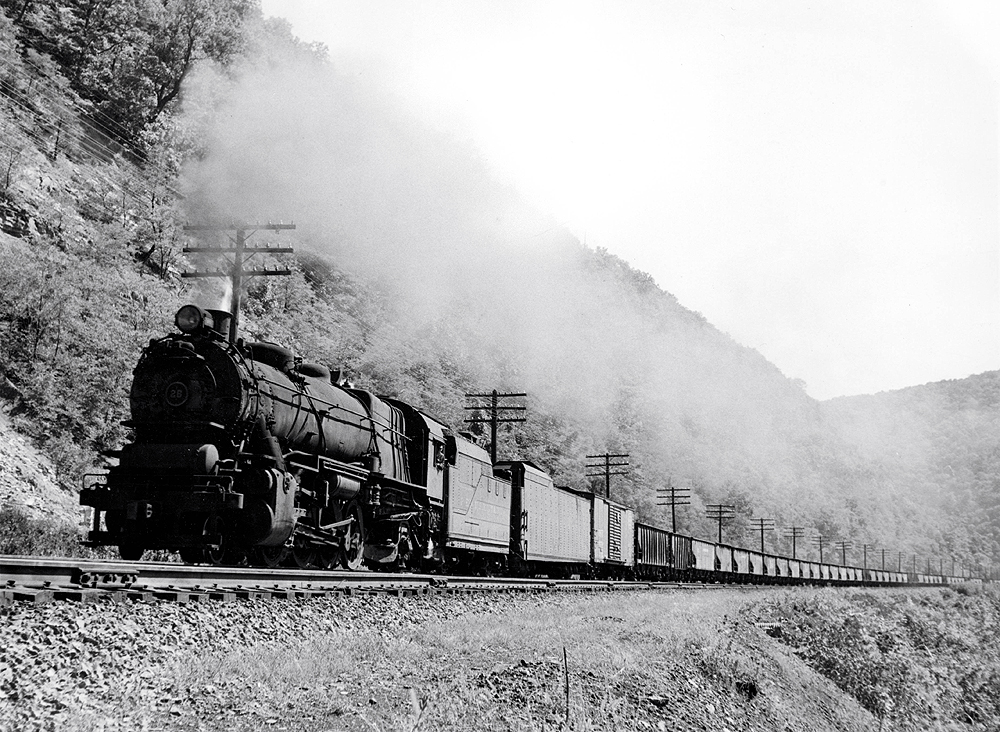
Steam on the brink of dieselization
L1s 2-8-2 Mikado No. 26 leads a train of empty coal hopper cars out of Renovo, Pennsylvania, toward Driftwood and the mines around Brady, in September 1955. Well on the way to dieselization by this time, the Pennsylvania had removed water stations from this part of the system, obliging the Mike to bring along an extra tender.
Philip R. Hastings
L1s 2-8-2 Mikado No. 26 leads a train of empty coal hopper cars out of Renovo, Pennsylvania, toward Driftwood and the mines around Brady, in September 1955. Well on the way to dieselization by this time, the Pennsylvania had removed water stations from this part of the system, obliging the Mike to bring along an extra tender.
Philip R. Hastings

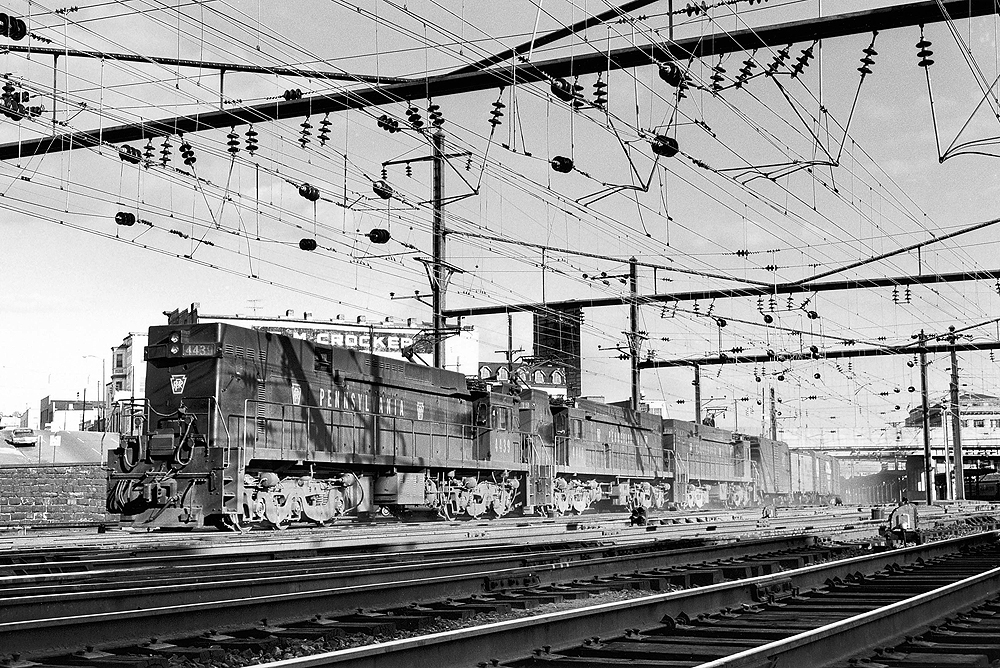
E44s in Baltimore
Three E44 electrics pass Penn Station in Baltimore with a freight bound for Potomac Yard in Alexandria, Virginia, in March 1966. Shortly the train will enter the tight, steeply graded B&P Tunnel. General Electric built 66 E44s for the Pennsylvania between 1960 and ’65.
Herbert H. Harwood Jr.
Three E44 electrics pass Penn Station in Baltimore with a freight bound for Potomac Yard in Alexandria, Virginia, in March 1966. Shortly the train will enter the tight, steeply graded B&P Tunnel. General Electric built 66 E44s for the Pennsylvania between 1960 and ’65.
Herbert H. Harwood Jr.

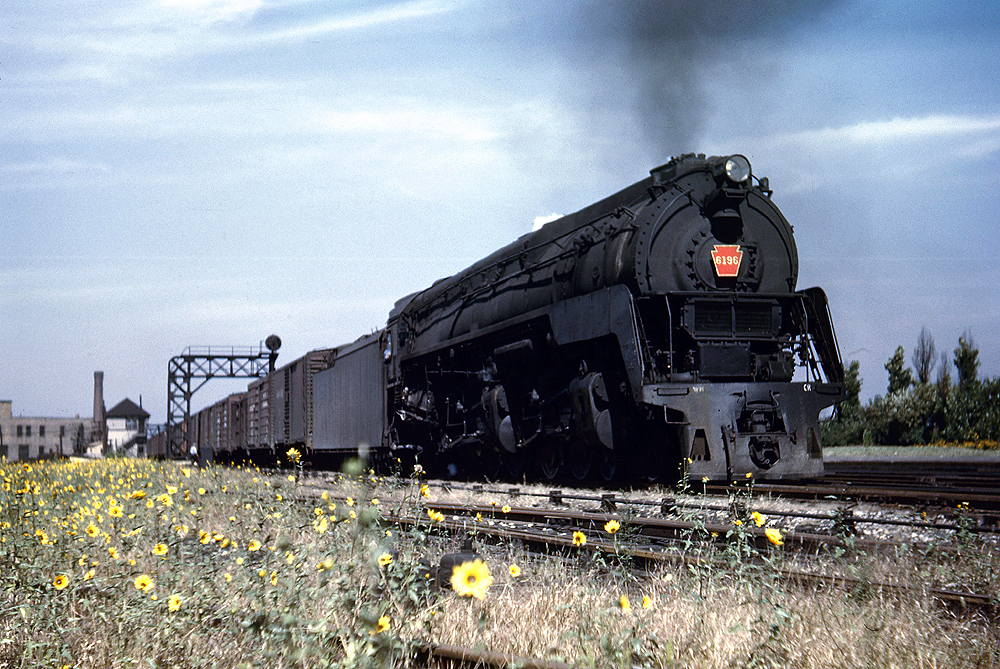
Duplex departing Chicago
Q2 4-4-6-4 duplex No. 6196 passes the interlocking tower and (hidden behind the train) passenger station at Englewood on the South Side of Chicago in the late 1940s. The Pennsylvania had 26 4-4-6-4 duplexes, built in 1944 and ’45 at its shops in Altoona, Pennsylvania.
Robert A. Caflisch
Q2 4-4-6-4 duplex No. 6196 passes the interlocking tower and (hidden behind the train) passenger station at Englewood on the South Side of Chicago in the late 1940s. The Pennsylvania had 26 4-4-6-4 duplexes, built in 1944 and ’45 at its shops in Altoona, Pennsylvania.
Robert A. Caflisch

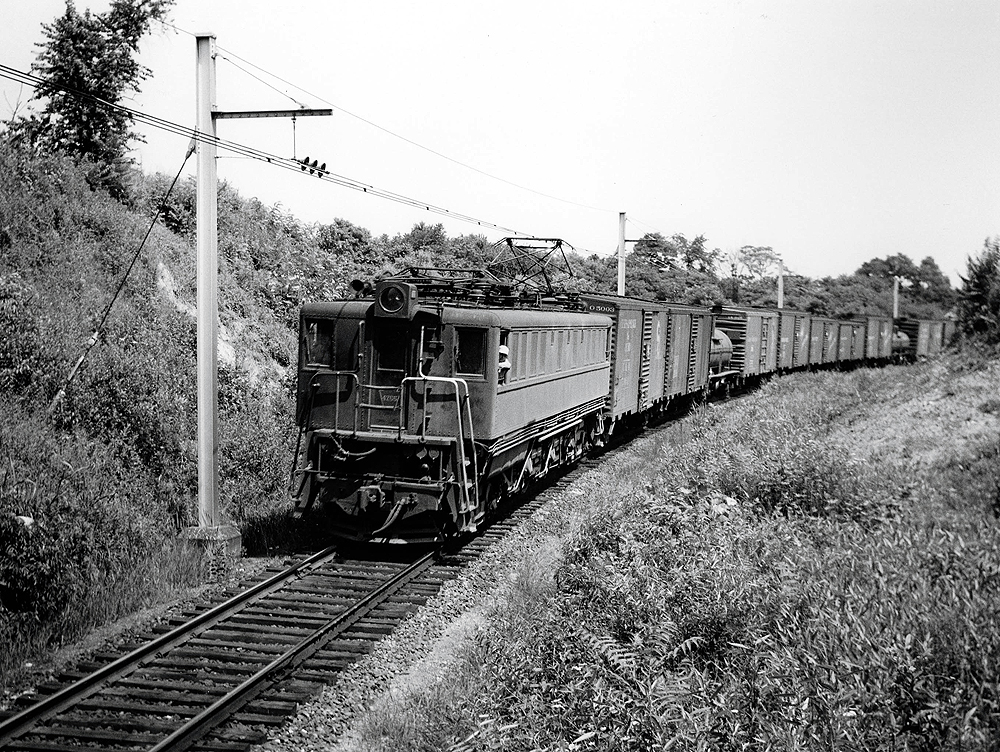
Under catenary in Virginia
A lone P5a box-cab electric approaches Potomac Yard in Alexandria, Virginia, with a freight from the north in June 1951. PRR’s 92 P5a motors, built in the early 1930s with a 2-C-2 wheel arrangement, came in a mix of box-cab and streamlined carbodies.
William E. Hopkins
A lone P5a box-cab electric approaches Potomac Yard in Alexandria, Virginia, with a freight from the north in June 1951. PRR’s 92 P5a motors, built in the early 1930s with a 2-C-2 wheel arrangement, came in a mix of box-cab and streamlined carbodies.
William E. Hopkins

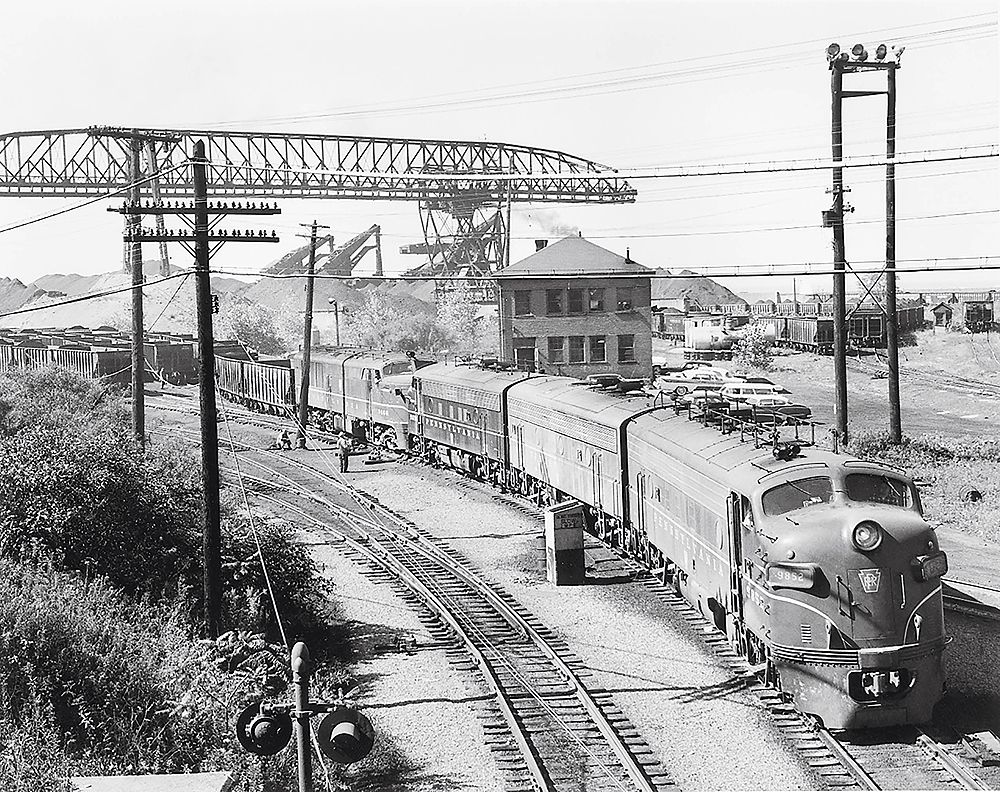
Iron ore out of Cleveland
Three EMD F7s and a Fairbanks-Morse Erie-built assemble an iron ore train at Pennsy’s Whiskey Island dock in Cleveland, Ohio, in October 1961. Lake vessels brought the ore in for unloading by the Hulett machines in the background.
Herbert H. Harwood Jr.
Three EMD F7s and a Fairbanks-Morse Erie-built assemble an iron ore train at Pennsy’s Whiskey Island dock in Cleveland, Ohio, in October 1961. Lake vessels brought the ore in for unloading by the Hulett machines in the background.
Herbert H. Harwood Jr.

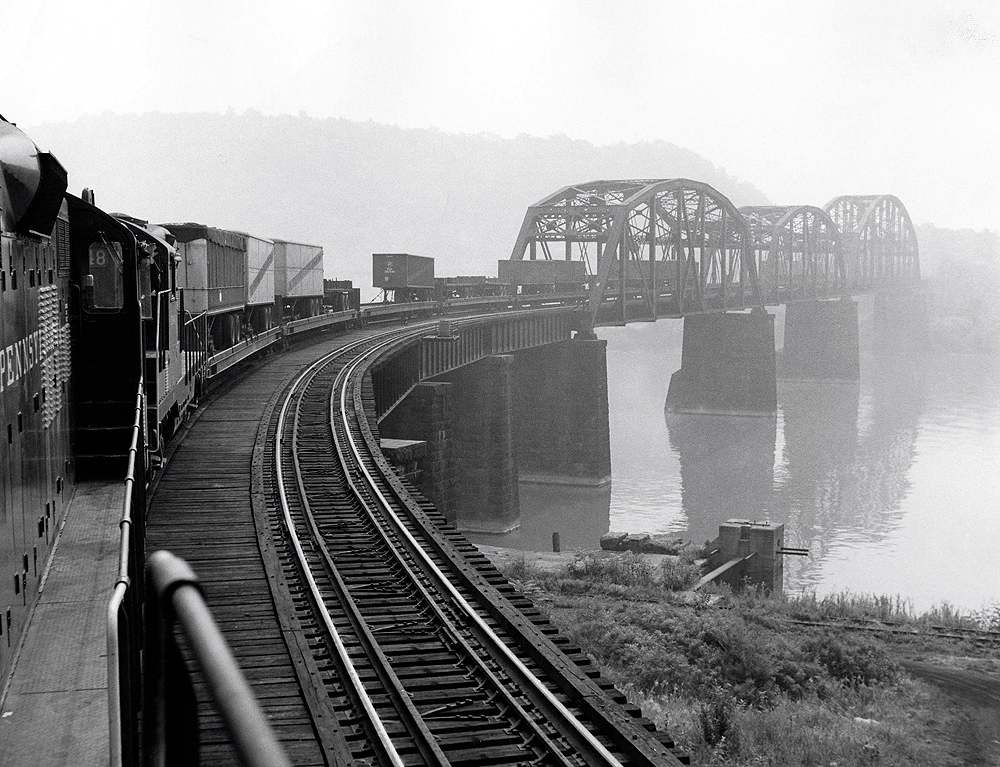
TrucTrain crossing the Allegheny
In a rearward view from one of the three GP9s on the head end, TrucTrain TT-1 crosses the Allegheny River at Freeport, Pennsylvania, in September 1956. The hotshot carried piggyback trailers between North Jersey and Chicago.
Philip R. Hastings
In a rearward view from one of the three GP9s on the head end, TrucTrain TT-1 crosses the Allegheny River at Freeport, Pennsylvania, in September 1956. The hotshot carried piggyback trailers between North Jersey and Chicago.
Philip R. Hastings

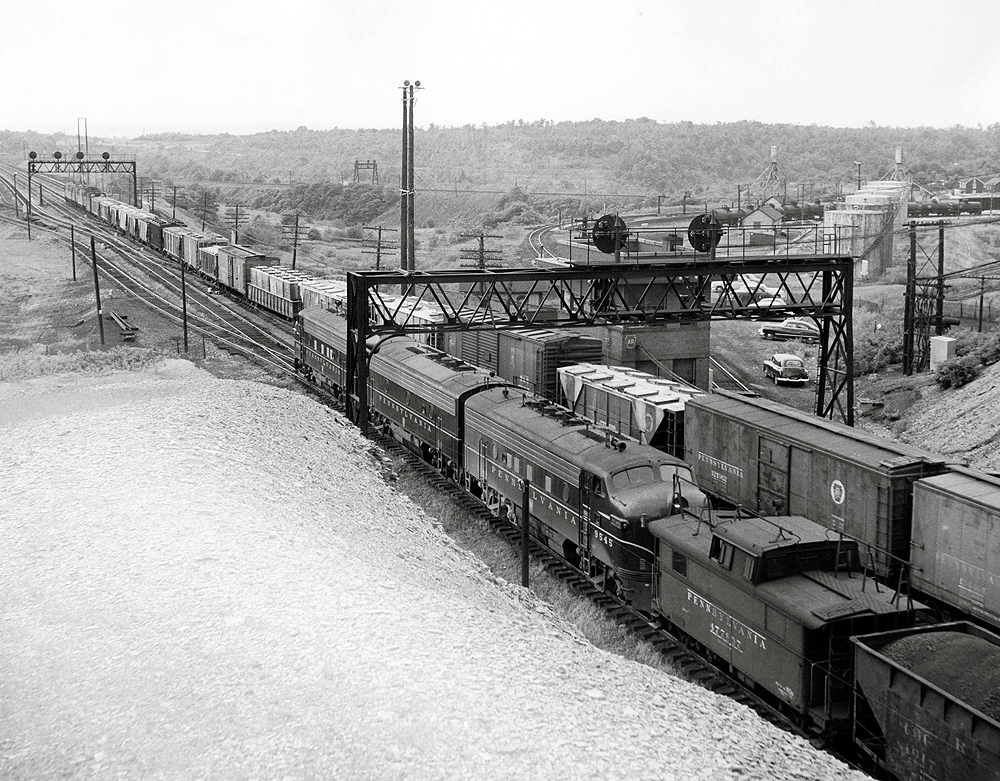
Top of the Pennsy
Two eastbound freight trains move past AR Tower at Gallitzin, Pennsylvania, summit of the PRR’s crossing of Allegheny Mountain, in September 1956. Both trains have pushers, three EMD F3s on one, and a two-unit set of Baldwin “Centipedes” on the other. The two tracks for westbound trains are in the background.
Philip R. Hastings
Two eastbound freight trains move past AR Tower at Gallitzin, Pennsylvania, summit of the PRR’s crossing of Allegheny Mountain, in September 1956. Both trains have pushers, three EMD F3s on one, and a two-unit set of Baldwin “Centipedes” on the other. The two tracks for westbound trains are in the background.
Philip R. Hastings

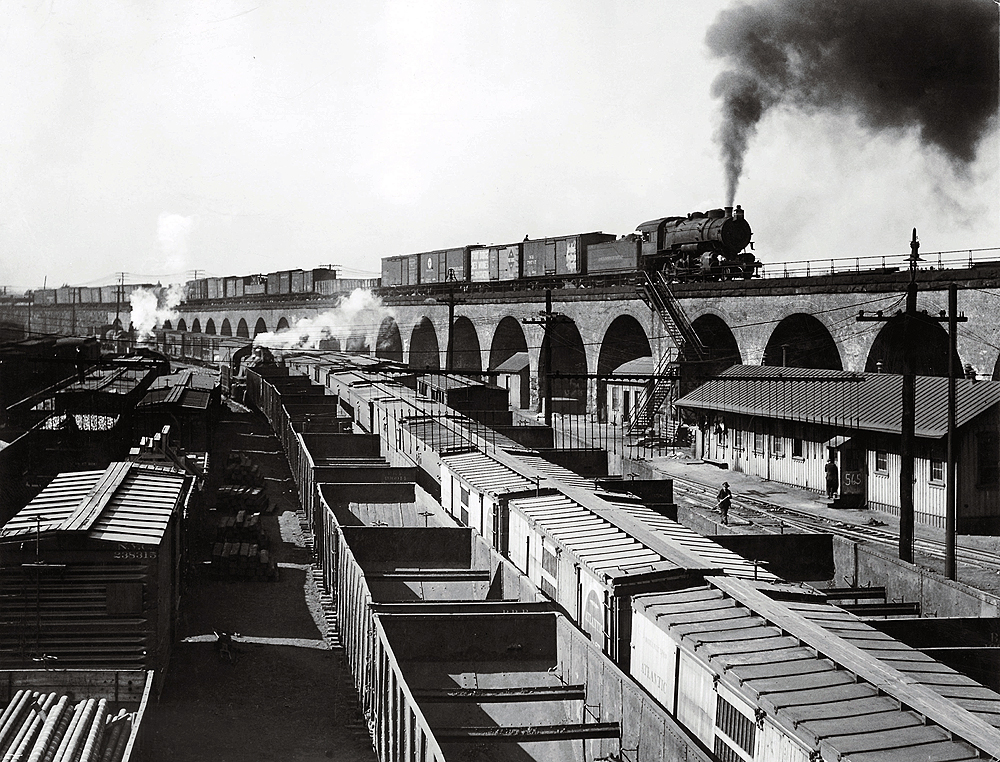
Freight on the High Line
An H8 2-8-0 Consolidation moves a freight along the West Philadelphia Elevated, a.k.a. the “High Line,” in the 1910s or early ’20s. PRR built the High Line for through freights to bypass the tangle of tracks on the west bank of the Schuylkill River in Philadelphia.
Harold M. Lambert
An H8 2-8-0 Consolidation moves a freight along the West Philadelphia Elevated, a.k.a. the “High Line,” in the 1910s or early ’20s. PRR built the High Line for through freights to bypass the tangle of tracks on the west bank of the Schuylkill River in Philadelphia.
Harold M. Lambert

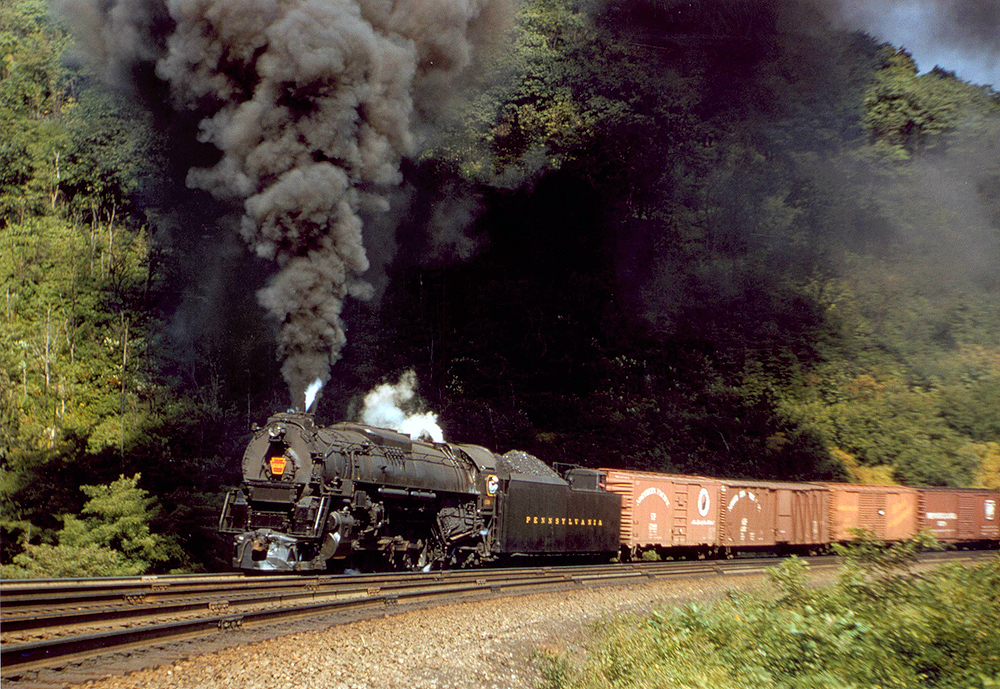
Horseshoe Curve
A J1 2-10-4 heaves a freight upgrade on the famous Horseshoe Curve in the Allegheny Mountains 5 miles west of Altoona, Pennsylvania, in the late 1940s or early ’50s. The speed of the ascent is indicated by the column of smoke standing straight up.
Classic Trains collection
A J1 2-10-4 heaves a freight upgrade on the famous Horseshoe Curve in the Allegheny Mountains 5 miles west of Altoona, Pennsylvania, in the late 1940s or early ’50s. The speed of the ascent is indicated by the column of smoke standing straight up.
Classic Trains collection

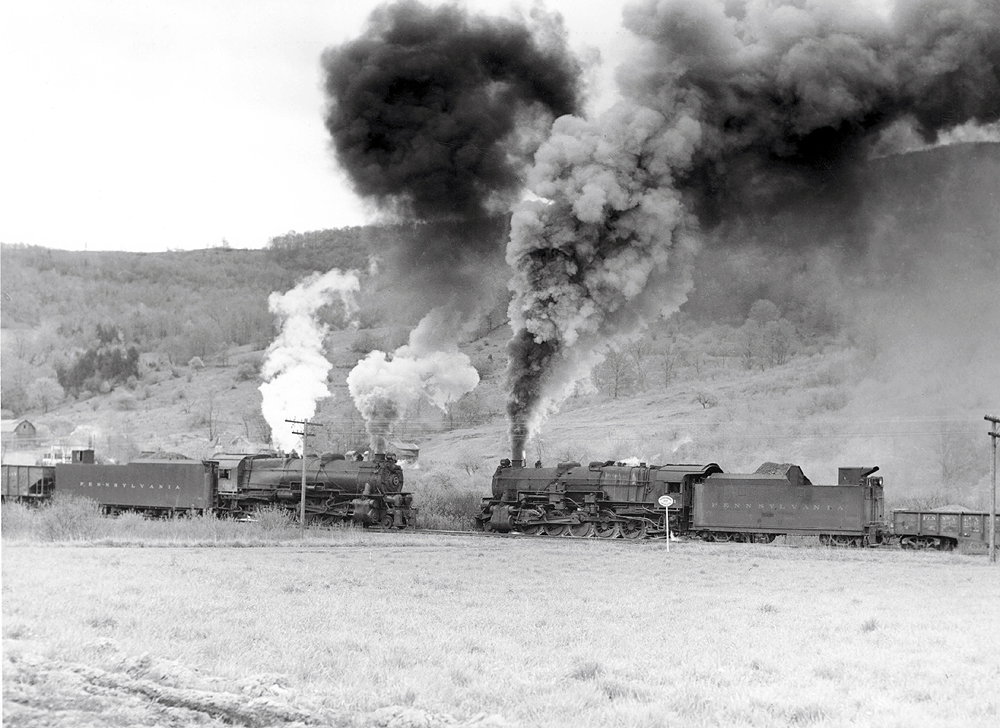
Hippo vs. Hippo
Two ponderous class I1 2-10-0 Decapods, nicknamed “Hippos” on the PRR, meet at a rural grade crossing along the road’s Elmira Branch near Troy, Pennsylvania, in May 1957. At left is a train of empty coal hoppers; at right is a local freight.
Jim Shaughnessy
Two ponderous class I1 2-10-0 Decapods, nicknamed “Hippos” on the PRR, meet at a rural grade crossing along the road’s Elmira Branch near Troy, Pennsylvania, in May 1957. At left is a train of empty coal hoppers; at right is a local freight.
Jim Shaughnessy

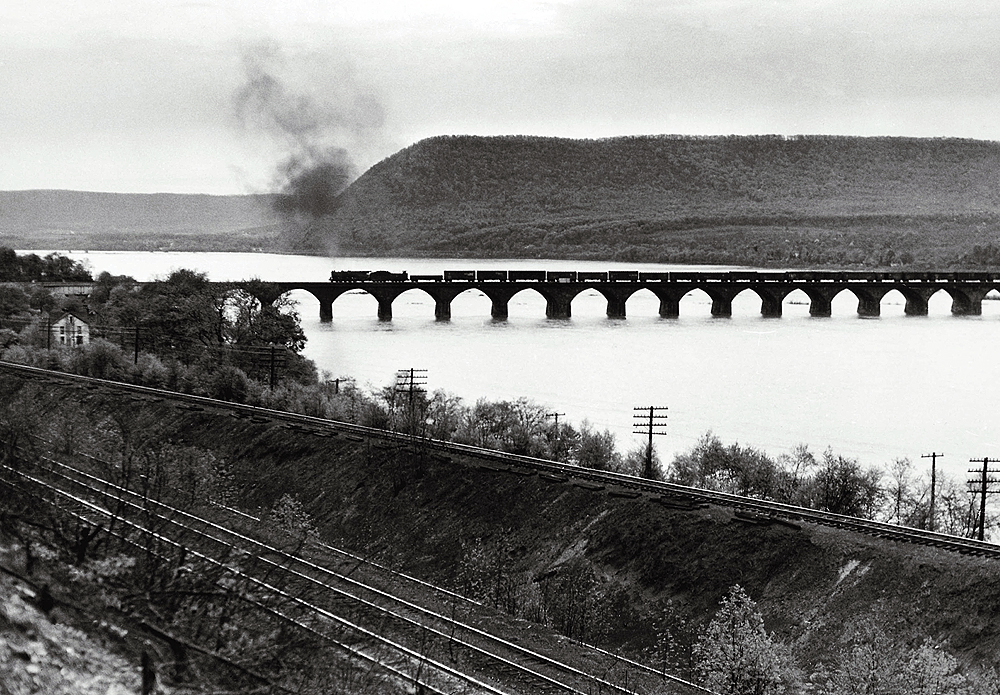
Rockville panorama
Sometime in the early 1950s, an M1 4-8-2 Mountain type leads a freight west across PRR’s landmark Rockville Bridge. Built in 1902, the 48-arch, 3,820-foot-long stone-and-concrete structure carries the Philadelphia–Pittsburgh main line across the Susquehanna River 5 miles north of Harrisburg, Pennsylvania.
F. L. Jaques
Sometime in the early 1950s, an M1 4-8-2 Mountain type leads a freight west across PRR’s landmark Rockville Bridge. Built in 1902, the 48-arch, 3,820-foot-long stone-and-concrete structure carries the Philadelphia–Pittsburgh main line across the Susquehanna River 5 miles north of Harrisburg, Pennsylvania.
F. L. Jaques

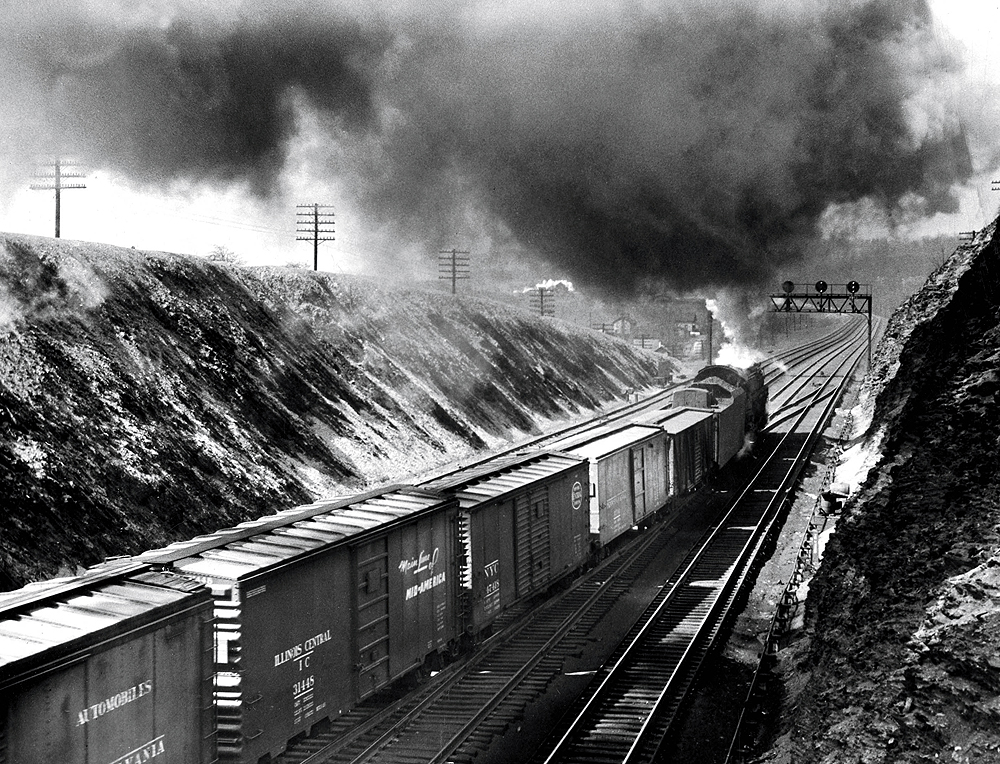
Making for the Mountain
Boxcars follow a J1 2-10-4 through Slope interlocking on the edge of Altoona in 1949. Five miles ahead is the landmark Horseshoe Curve.
Linn H. Westcott
Boxcars follow a J1 2-10-4 through Slope interlocking on the edge of Altoona in 1949. Five miles ahead is the landmark Horseshoe Curve.
Linn H. Westcott

All this month — January 2020 — Classic Trains editors are celebrating the heritage, history, and images of the Pennsylvania Railroad.
Please enjoy this photo gallery of images from the David P. Morgan Library archives at Kalmbach Media that include Pennsy diesel- and steam-powered freight trains through time.
You might also enjoy this PRR history article from Classic Trains or a photo gallery of Pennsy passenger trains!














The Pennsylvania Railroad was a large system. While certain parts of it seem to get the bulk of the attention, there was a lot going on in various parts of its far flung trackage. Through those PRR years, I enjoyed seeing what was to be found along its track north of Ft. Wayne, IN into Michigan, running the length of the Lower Peninsula. Some refer to this as the GR&I, but for me it was always the Pennsylvania with its own unique aspects including: stations, towers, signaling, N6b cabin cars, road freights, way freights, yard & industrial switching, and so on. As far as motive power, I remember the EMD F-units, Geeps, and end-cab switchers, but also: Fairbanks-Morse Erie-built units, EMD Geep B-units, inductive train phone antennae, multi-unit lashups, Alco RS-2s and RS-27s, Bangor and Aroostook leased Geeps. Yes, the PRR was interesting in its style.
My grandfather was a yardmaster at South Fork , Pa. The rest of the family lived in the Ferndale section of Johnstown. I remember a lot of days train watching . I was born in Palermo , NJ, PRSL territory. I could board in Palermo or Ocean City, and ride to 30th. Street in Philadelphia where I connected to a West bound and get off in Johnstown. We used to go to Renovo a lot, or up to Newbury Junction and take the road along Pine Creek to see the New York Central run down from Wellsboro, or go east a bit and go up to Trout Run to watch the Pennsy going up , or down from Elmira, and further north , maybe Sodus Point on the big lake.. The PRR was a big part of my family, and when Gramps died the trains coming through South Fork blew their whistles or sounded their horns in a long wail as a tribute to a loyal PRR man ! The company was very good to my grandmother and never forgot her ! The Ferndale part of the family all worked for US Steel, or mined coal , and some worked on the Johnstown Traction Co., a long lived trolley system . I heard many stories about the terrible flood in 1889. I have been back several times to see the old houses in the old neighborhoods and re-live the great days of train watching and riding !!
Philip Hasting’s J1 picture on Horseshoe Curve could not have been taken before 1954, given the lettering on the PRR boxcar back in the train. In “McGuire terminology” (which we use in the Pennsylvania Railroad Technical & Historical Society), the car is carrying Shadow Keystone 1b (SK1b) standard lettering.